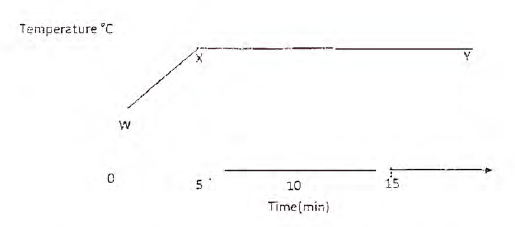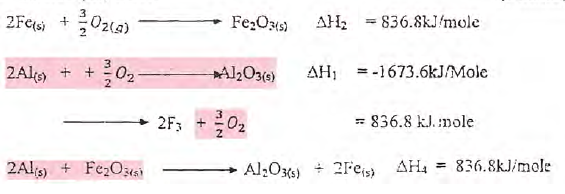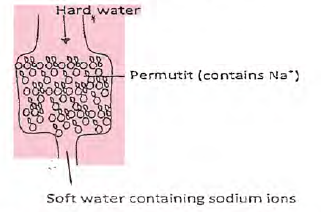- Explain why hydrogen has oxidation states of +1 and -1 in its compounds.
- Excess iron filling were allowed to rust in 1dm3 of moist air and the volume of the remaining air was measured each day.
Day 0 1 2 3 4 5 6 7 8 Volume of air cm3 1000 950 900 860 840 820 800 800 800 - Why did the volume of air remain constant from day six? (1 mark)
- Determine the percentage of oxygen in air using the data given in the table. (1 mark)
- Give two reasons why air is a mixture but not a compound. (1 mark)
- The products formed by action of heat on nitrates A, B and C are shown below.
Nitrate Products formed A metal oxide + nitrogen (IV) oxide + oxygen B metal + Oxygen + nitrogen (IV) oxide C Metal nitrate + oxygen - Arrange the metal elements in order of increasing reactivity. (1 mark)
- Which element forms a soluble carbonate? (1 mark)
- Give an example of element B. (1 mark)
- The graph below shows a curve obtained when water at 20oC was heated for 15 minutes.
- What happens to the water molecules between points W and X. (1 mark)
- In which part of the curbe does a change of state occur? (1 mark)
- Explain why the temperature does not rise between point X and Y. (1 mark)
- Aluminium metal is a good conductor and is used for overhead cables. State any other two properties that make aluminium suitable purpose. (2 marks)
- Ammonia can be converted to nitrogen (II) oxide as shown in the equation below.
- Explain how an increase in temperature would affect the yield of nitrogen (II) oxide. (2 marks)
- On the energy level diagram above sketch the energy level diagram that would be obtained in the reaction is carried out in presence of a platinum catalyst. (1 mark)
- A piece of cover slip was weighted before and after a student made a mark on it using a pencil of pure graphite. The masses were as shown below.
Mass of cover slip before the mark = 1.804g
Mass of cover slip after the mark was made = 1.9053g
Determine the number of carbon atoms used to draw the circle. (C = 12, L = 6.02 x 1023) (3 marks) - You are given the following information about aqueous Y and X.
Explain the difference in electrical conductivity of solution X and Y.Aqueous solution pH Electrical X 6 1.3 y 2 3.8 - 5.04g of a mixture of anhydrous sodium carbonate and sodium hydrogen carbonate when heated to a constant mass, give 4.11g of residue.
- Write an equation for the reaction that takes place when the mixture is heated. (1 mark)
- Calculate the percentage of anhydrous sodium carbonate in the mixture. (2 marks)
- Yellow phosphorous reacts with chloride gas to form a yellow liquid. The liquid fumes when exposed to air. Explain these observations. (2 marks)
- Hydrated copper (II) sulphate exists as blue crystals and anhydrous copper (II) sulphate is a white powder. Describe a laboratory experiment that can be used to show that the action of heat on hydrated copper (II) sulphate is reversible action. (3 marks)
- The table below gives the solubilities of substances J, K and L at different temperatures.
Substances Solubility in grammes per 100g water at 0oC 20oC 40oC 60oC J 0.334 0.16 0.097 0.0058 K 27.60 34.0 40.0 45.5 L 35.70 36.0 36.6 37.3 - Use the following equations to determine the heat evolved when aluminium metal is reacted with iron (III) oxide. (3 marks)
- Give the formula of an oxide which reacts with both dilute hydrochloric acid and hot concentrated sodium hydroxide solution. (1 mark)
- Give the formulae of the products formed when the oxide in (a) above reacts with excess hot concentrated sodium hydroxide. (1 mark)
- In an experiment, sulphur (IV) oxide was bubbled into water followed by chlorine gas. The resulting clear solution gave a white precipitate when mixed with acidified barium nitrate solution. Explain these observations. (3 marks)
- The column below was used to soften hard water.
- Explain how the hard water was softened as it passed through the column. (1 mark)
- After sometime the material in the column is not able to soften hard water. How can the material be reactivated? (1 mark)
- Give one advantage of using hard water for domestic purposes. (1 mark)
- The column below was used to soften hard water.
- Starting with 50cm3 of 2M sodium hydroxide, describe how a sample of pure sodium sulphate crystals can be prepared. (3 marks)
- A sealed glass tube containing air at s.t.p was immersed into water at 100oC. Assuming there was no increase in the volume of the glass tube due to the expansion of the glass, calculate the pressure of the glas inside the tube. (Standard pressure = 760mmHg, standard temperature 273K). (3 marks)
- A sample of hydrogen gas was found to be a mixture of two isotopes. Determine the relative molecular msas of the molecule formed, when each of these isotopes is burnt in oxygen. (O = 16) (2 marks)
-
Species Number of electrons Number of Neutrons 3115P3- 11H and 21H - Starting with red roses, describe how,
- A solution containing the red pigment may be prepared. (1 mark)
- The solution can be shown to be an indicator. (2 marks)
- Use the cell represented below to answer the questions that follow.
Cr(s) / Cr3+(aq) // Fe2+(aq) / Fe(s)- Write the equation for the cell reaction. (1 mark)
- If the e.m.f of the cell is 0.30 volts and Eθ value for Cr3+(aq)/Cr(s)
- Distinguish between nuclear fission and nuclear fusion. (2 marks)
- The diagram below shows an iron bar which supports a bridge. The iron bar is connected to a piece of magnesium metal block.
Explain why it is necessary to connect the piece of magnesium metal to the iron bar. (3 marks) - What name is given to the process by which pure alcohol is obtained from crude alcohol? (1 mark)
- Explain why the solubility of ethane in water is lower than that of ethanol. (2 marks)
- Give two reasons why most laboratory apparatus are made of glass. (2 marks)
- Describe how the percentage mass of copper in carbonate can be determined. (3 marks)
- Dry carbon (II) oxide gas reacts with heated copper (II) oxide as shown in the equation below.
CuO(s) + CO(g) --------> Cu(s) + CO2(g)- Name the process undergone by the copper (II) oxide (1 mark)
- Give a reason for your answer in (a) above. (1 mark)
- Name another gas that can be used to perform the same function as carbon (II) oxide. (1 mark)
- State and explain what would happen if a dry red litmus paper was dropped in a gas jar of dry chlorine. (2 marks)
Join our whatsapp group for latest updates
Tap Here to Download for 50/-
Get on WhatsApp for 50/-
Download Bunyore Maranda MOCKS 2016 Chemistry Paper 1.
Tap Here to Download for 50/-
Get on WhatsApp for 50/-
Why download?
- ✔ To read offline at any time.
- ✔ To Print at your convenience
- ✔ Share Easily with Friends / Students






